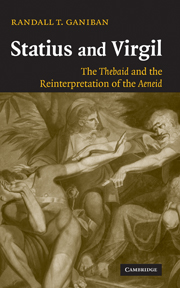Book contents
- Frontmatter
- Contents
- Preface
- List of abbreviations
- 1 Introduction
- 2 Oedipus' curse
- 3 Horror, prophecy, and the gods
- 4 Hypsipyle's narrative of nefas
- 5 Bacchus and the outbreak of war
- 6 Dis and the domination of hell
- 7 Delay and the rout of Pietas
- 8 Spectacle, crime, and monarchy at Thebes
- 9 Pietas, burial, and clementia in a world of nefas
- Works cited
- General index
- Index locorum
8 - Spectacle, crime, and monarchy at Thebes
Published online by Cambridge University Press: 22 September 2009
- Frontmatter
- Contents
- Preface
- List of abbreviations
- 1 Introduction
- 2 Oedipus' curse
- 3 Horror, prophecy, and the gods
- 4 Hypsipyle's narrative of nefas
- 5 Bacchus and the outbreak of war
- 6 Dis and the domination of hell
- 7 Delay and the rout of Pietas
- 8 Spectacle, crime, and monarchy at Thebes
- 9 Pietas, burial, and clementia in a world of nefas
- Works cited
- General index
- Index locorum
Summary
The rout of Pietas by the Fury Tisiphone is a central moment in the Thebaid, but not the culminating one. It is the precursor to a more basic goal: the brothers' fratricidal deaths. This is what Oedipus had prayed for, and what Tisiphone strives for from the opening of the epic. In this chapter I will examine the final confrontation between Eteocles and Polynices and show how its spectacular nature and its involvement in cosmic strife underpin the epic's critique of absolute power and dialogue with Virgil. In moving from the Augustan Aeneid to the Thebaid, the duel makes clear that we have turned from a world of idealized pietas to one defined by nefas.
THE SPECTACLE OF NEFAS: WATCHING THE ROUT OF JUPITER
As we saw in the previous chapter, the theme of delay is a major element of the build-up to the brothers' duel, but it is intermingled with another motif, that of spectacle. Despite the continual declarations about the poem's violent goal, despite the pervasiveness of the infernal powers, the performance and viewing of fraternal violence still pose problems – even for those who have consistently promoted it. Consequently, as the duel approaches, a basic question will face all characters: should the end of the war – should fratricide – be watched? In this section I will first discuss the importance of spectacle metaphors in book 11, and then examine how the representation of the fratricidal violence contributes to the politics and pleasures of Statius' poetic world.
- Type
- Chapter
- Information
- Statius and VirgilThe Thebaid and the Reinterpretation of the Aeneid, pp. 176 - 206Publisher: Cambridge University PressPrint publication year: 2007



